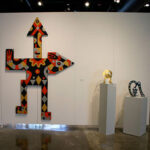
Paintings by Letts and Kupencow
- Jun 29 2007 - Jul 29 2007
- Expired!
Michael Letts. Landscape as a Metaphor. Environment shapes who we are. His paintings echo the northern forests of the UP of Michigan in every season. But the images represent more than the visual. There is the suggestion of deeper experiences, of landscape as metaphor. Most of the painting are drawn from specific places that resonate in memory, places that strike with their presence, enchanted places. They suggest a primal geometry and recall the forest as a place of destiny and growth, of wildness and of peace. His paintings recall the vision quests and rites of passage of a time when we lived closer to our spirits.
Eleanora Kupencow lives and works in Manhattan, New York and has exhibited her works nationally and internationally.
“Your colors are Polish” – Kupencow was told by her art teacher Evsa Model. She herself confirmed that observation during her trip to Poland in the early 1980s. “The Polish love to use magenta and organge along with red, as I do.” Apart from a particular “Polish” tonality toy her work, which, infact, varies quite significantly form painting to painting and has been recently enriched by silver and gold, Kupencow;s art displays a stong affinity with Polish folklore. Pristine expressive pattern and blazing colors in her works can be also found in the glass paintings from the Podhale region in the Tatra Mountains and the paper cut-outs snipped with sheep shears by women in different parts of Poland. Artists tend, however, to absorb visual stimuli in a free way. Kupencow credits Islamic miniatures Christian illuminated manuscripts, Coptic textiles, and Northwest Coast Indian art for infusing her imagination with their combination of distinctive ornamentation and evanescent beauty. Her strong interest in applied art goes back to her childhood, when “making things was a good thing to do” and “dipping Easter eggs in dye was the closest our family ever came to painting.”
Kupencow’s works hit the viewer with their formal directness and boldness that verge on te outrageous. They are flat, geometricized, and closely packed with forms wrapped around each other in a space divded into distinctive positive and negative (foreground and background) areas. Dwarfed, abstracted creatures, often abbreviated to their upper bodies or just their faces, fill out a canvas or a piece of paper. Kupencow simplifies the narrative trope, or turns it into a visual pun, allowing free-associations. She returns to the same motifs: figures in landscape and faces. Her images radiate a genuine fascination with re-drawing forms, which because of her wild imagination are not predictable and tenuous, even when they appear as close variations on ones already known from Kupencow’s other works. It seems as in her approach to art making, the artist aims at surprising herself by finding new permutations of previously explored imagery, and while conjuring them – she surprises the viewer.